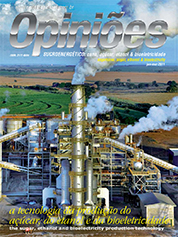Dimas Alfredo Barros Cavalcanti
Director of Moex
Op-AA-27
Our conquests and the next challenges
Nowadays, we are increasingly committed to seeking results that are no longer restricted to achieving excellence in crushing capacity – whether by means of crusher or diffuser. It has become imperative to take the environment into consideration and in doing so one sacrifices the crushing and the extraction.
The inconvenience of not burning cane in the fields and not washing it inside the mills increased the challenges and the difficulties in reaching increasingly more ambitious targets in terms of crushing and extraction. We shall have to overcome this phase. After all, it was thanks to much dedication that Brazil became a reference in the area of sugarcane processing.
Until recently we sought to achieve increasingly more crushing volume, whether in the existing mills or in new units, while being unable to diminish extraction rates. As a consequence, many preparation and crushing equipment units in need of repair piled up in maintenance shops.
In the last ten years, we began to improve shredders, increasing their peripheral speeds, their shredder grids and their feed drums, seeking to achieve preparation indices (or open cells) at a rate of 90% (the less power consuming ones increased from 82/85% to 87/90%).
This was intended to achieve a high extraction rate in the first mill unit (about 4%) and a little in the overall mill tandem (from 0.5 to 1.0%), while simultaneously increasing the crushing mills’ crushing capacity. The existing crushing units underwent upgrading and reached higher capacities (60 to 70%), considering a same mill size. New installations have already incorporated improvements made to new equipment.
Preparation and crushing equipment are bigger now – the smallest mill size is currently 78” – in most new projects, because mills are designed for crushing 4 to 5 million tons of sugarcane per harvest. Nowadays, equipment with nominal mill size of 90” and 100” is common. We already have mills crushing 1,100 tons of cane per hour and others ready to operate at this level.
From a mechanical point of view, crushing mills became more reliable as a consequence of increasing market demand. The entry of entrepreneurs from other industries in our sector, such as equipment users, helped foster this requirement, while the development of materials and their increasing application brought about a reduction in costs.
The use of electric drives became economically and technically feasible, thermal efficiency in mills improved, as did vapor consumption in the process and efficiency of large boilers and turbines. All this allowed installing individual roll drivers that nowadays achieve outstanding operational versatility and savings in the maintenance of crushing mills, a considerable increase in the extraction rate (references to values in excess of 1% we deem exaggerated).
This matter is not universally accepted because, in the beginning, the system did not provide many benefits: there were conceptual errors in electric installation projects of frequency converters. Another major improvement, apart from the electrification of the crushing mill (including preparation), has been, and still is, automation.
Since such operational difficulties are constantly growing, we have reached a scenario in which, unless there is a system that assists and optimizes important aspects and parameters, so as to remain within narrow range, to attain good results will become impossible. Nowadays, we are able to uphold extraction (in terms of volume) tuned to the required rate, so as to produce sugar and ethanol as planned, independently of variations in the quality of the sugarcane entering the crushing mill (more juice, less juice, etc.).
Systems that control mill rolls' speeds, the upper rolls' floatation, the pump juice and imbibitions flowing are available to fine tune extraction and keep it at the best rate possible throughout the entire harvest. However, going back to the beginning, in the last three years, the accelerated growth in crushing sugarcane with large volumes of straw and earth (because of the environment) has presented the new challenge of crushing a lot, extracting a lot, warranting a good result during the entire harvest, and preserving equipment for as long as possible.
This has been a major challenge, because straw is damaging the extraction of the crushing mill (a little) and the extraction of the diffuser (a lot). Earth is damaging to the crushing mill (in terms of wear, with consequences for upholding a good extraction during the harvest) and to the diffuser (in terms of wear and extraction during the entire harvest).
Therefore, the development needed now is to separate or diminish straw and earth from sugarcane, in the fields or in the mills (a lot has been done in this regard with the dry cleaning systems) and the development of materials and linings highly resistant to wear.




